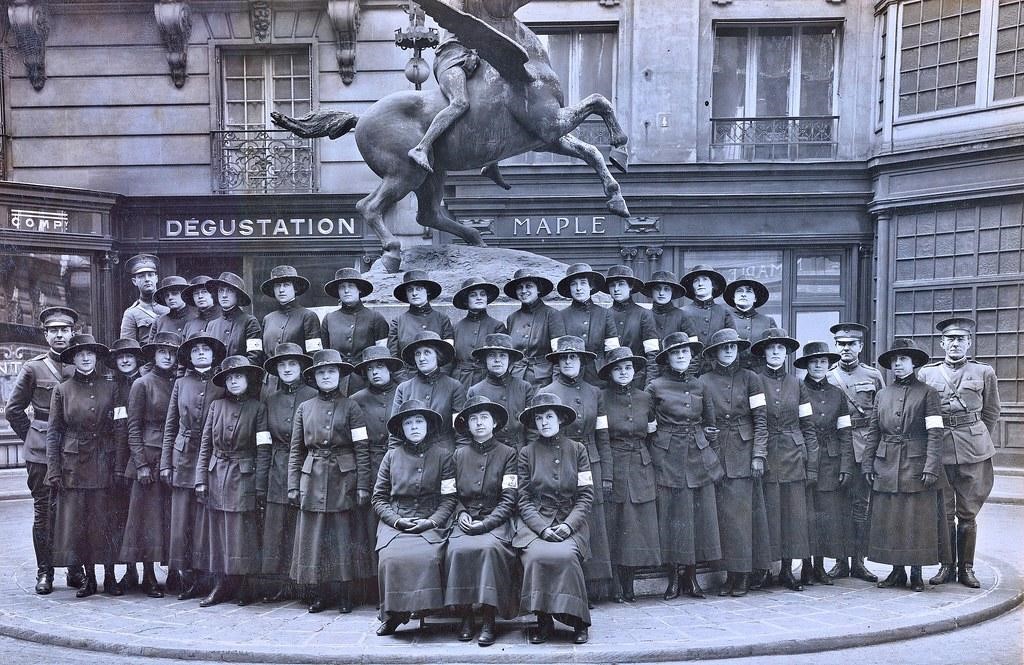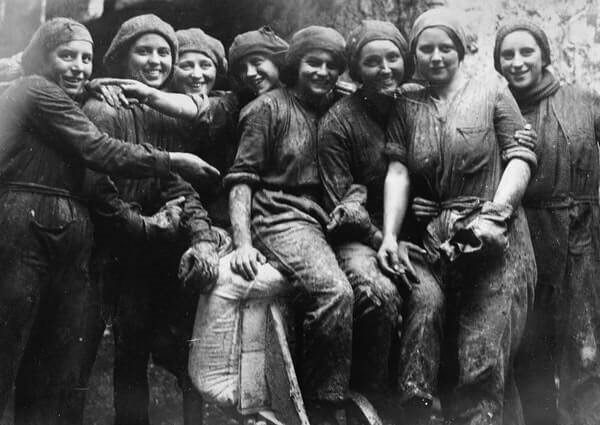Roles Taken Up By American Women in World War I
Published: 4 March 2023
Special to the Doughboy Foundation web site

Hello Girls group
(U.S. Army Telephone operators, known as the "Hello Girls" pictured in France during WWI.
(Top Image: “American Telephone girls for ‘Hello’ duty” by over 26 MILLION views Thanks – CC BY-NC-SA 2.0)
World War I is known as the first modern war, that is, the first international war to use mechanical devices such as tanks and airplanes. This war is also the first to include the participation of women, although the war is often thought of as just a men-led movement. At the time of the war effort, American women had yet to obtain the right to vote, and the women’s suffrage movement was at its height.
While five million men were mobilized from America for WWI, over seven million women participated in the war effort at home and overseas. Some of these women joined the military forces directly, often as nurses, similar to nurse Hana in the 1996 film The English Patient on fuboTV, while others took the jobs of men who had left for battle.
Women in Support Roles
Thousands of women acted in supporting roles during WWI as translators, nurses, doctors, and ambulance or truck drivers on the front lines. While automobiles were still new at the time, most women who knew how to drive volunteered to operate ambulances and trucks carrying medical supplies for the military, and some others learned how to repair these vehicles to become mechanics. A lot of these women were exposed to artillery fire while driving.
Another common job for women during the war was nursing, specifically acting as nurses in the U.S. Army Nurse Corps and the Navy Nurse Corps. Over 3,000 of these nurses were sent ahead of the troops to help operate British-operated hospitals in Britain and France. Some women also volunteered to become nurses for the American Red Cross and the Salvation Army, which sent women into battlefields to retrieve wounded military members. Hundreds of these women died in combat zones.
Some women also became doctors and surgeons during the time of WWI, although they were not yet accepted by the American Army Medical Corps. Instead, these women found jobs working with humanitarian organizations, such as the Medical Women’s National Association, which sent over 80 female doctors to the frontlines in Europe during the war.
Other women volunteered for jobs that provided services to military soldiers. For example, the American Red Cross accepted “Lassies” that brought coffee, breakfast items, and written letters to soldiers on the front. These Lassies also provided soldiers with services like clothes mending and washing. Another organization, America’s Librarians, recruited women volunteers to supply books, periodicals, and magazines to troops. With over five million dollars in donation funds, this organization relied on over one thousand women to deliver nearly ten million books to 36 individual book camps in Europe.
Women in Industry
Perhaps the most common roles that women took during World War I were roles in industries at home in the United States. Prior to the war, society deemed it too masculine for women to take roles outside of their households; however, women were needed to work in factories to build aircraft and other materials for the war effort, so these ideas soon shifted. Some women also took the other traditional jobs of men that needed to be filled after the men were deployed, like farming and office work. African American women also made a large shift from housekeeping work to office and factory-related work outside of the home during this time.
Even women who did not choose to work outside of their homes were asked to sign pledges that required them to become their households’ “Food Administrators.” This held all women accountable for growing and preserving their own food as much as possible in order to lower the stress on American farmers.
Women in the Military

(Image: “Women from WW1” by The American Opera Project – CC BY-NC-SA 2.0)
While it was less common, there were still many women who joined the military directly during WWI. Most of these women signed up to join the U.S. Navy as “Female Yeomen.” These women Yeomen filled clerical roles where there were not enough men to fill them, usually in offices to act as radio operators, camouflage artists, and munition workers. Some of the women who drove ambulances or supply trucks for the military were also recruited as women Yeomen. All female Yeomen were given the same status as the men in the Navy and were paid the same monthly salary. During the entirety of the war, it is estimated that about 12,000 women Yeomen existed.
Women who could act as translators often joined the military or supporting organizations to become translators. Over seven thousand women also became “Hello Girls,” which were phone operators for the U.S. Army at home and abroad.
During WWI, American women were unable to fight in active combat. However, Russian, Romanian, and Bulgarian women rose up to join their own countries’ military forces. Maria Bochkareva of Russia was one of these women who became a decorated soldier after creating the first all-female Russian battalion. Her group, named the Women’s Battalion of Death, not only saw live combat but encouraged other women and men to join the Russian military efforts.
Women’s Suffrage
The height of the first World War coincided with the height of the women’s suffrage movement in America. As a result of women’s direct involvement with the war, millions of American women were forced to put their own lives on hold, meaning they had to wait to grow their families or pursue a college education. Not only that, but at least six hundred women were documented as dying on the frontlines in the war. Suffragists brought these documented sacrifices to President Wilson as support for women to gain their full right to citizenship, specifically to win the right to vote.
Eventually, President Wilson gave his support to the Susan B. Anthony bill, which would be debated by the American Congress for nearly two years before it was passed. This bill then ratified the U.S. Constitution, adding the nineteenth amendment in 1920.
Summary
Women played vital roles in World War I, including roles both on the frontlines and at home. Over seven million women participated as translators, drivers, operators, industry workers, nurses, and doctors while many more pledged to help the war effort by preparing all the food their households needed at home. Some women also lost their lives on the frontlines, which only helped fuel the suffrage movement until all American women won the right to vote as citizens.
External Web Site Notice: This page contains information directly presented from an external source. The terms and conditions of this page may not be the same as those of this website. Click here to read the full disclaimer notice for external web sites. Thank you.



